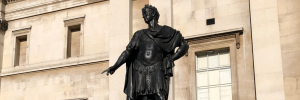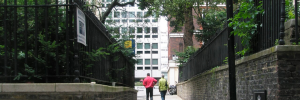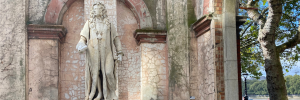Suspended high on a wall in the Victoria and Albert Museum is the facade of a London house from before the Great Fire of 1666.
It is a complex succession of curves and angles forming two windows which give rise to a semi-circular column in the centre. The wooden panels are decorated with scrolls, masks, cartouches and strapwork.
The house belonged to Sir Paul Pindar, the English consul in Aleppo and subsequently ambassador to the Ottoman court. Pindar traded in alum and tobacco and helped administer England’s customs revenues. He also lent money to James I and Charles I.
He died in 1650 and his house was then sub-divided. In the eighteenth century it became a tavern, called the Sir Paul Pindar’s Head. The house met its end in 1890 when it was pulled down by the Great Eastern Railway to allow for the expansion of Liverpool Street Station.
The frontage is a rare survival from a timber-framed house from before the Great Fire, and gives some idea of what the capital looked like, though Pindar’s house was unusually ornate. It was also large, being much wider than the part preserved in the V&A.
Traces of paint remain, and though not really visible to the museum visitor these suggest the facade was painted in a red-brown with a contrasting stone colour.
Get further information on the conflagration of 1666 on our Great Fire of London Walk. Private tour also available here.
To see Pindar’s House visit the V&A, open daily 10.00 to 17.45 (Fridays 10.00 to 22.00).



